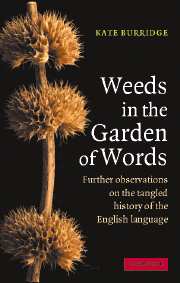Book contents
- Frontmatter
- Contents
- Acknowledgments
- Introduction to the Weedy Traits of the English Language
- Our Lexical Weeds: the World of Jargon, Slang and Euphemism
- More Lexical Weeds: Word Origins and Meaning Shifts
- Our Grammatical Weeds
- Weeds in Our Sounds and Spelling
- The Truly Nasty Weeds of the English Language?
- W(h)ither Our Weeds?
- Bibliography
- List of Interesting Words
Introduction to the Weedy Traits of the English Language
Published online by Cambridge University Press: 22 September 2009
- Frontmatter
- Contents
- Acknowledgments
- Introduction to the Weedy Traits of the English Language
- Our Lexical Weeds: the World of Jargon, Slang and Euphemism
- More Lexical Weeds: Word Origins and Meaning Shifts
- Our Grammatical Weeds
- Weeds in Our Sounds and Spelling
- The Truly Nasty Weeds of the English Language?
- W(h)ither Our Weeds?
- Bibliography
- List of Interesting Words
Summary
Weeds, as a class, have much in common with criminals.
When not engaged in their nefarious activities both may have admirable qualities; a thief may be an affectionate husband and father outside business hours; an aggressive weed in one environment may be a charming wild flower in another.
Sir Edward Salisbury puts it beautifully in the preface to his book The New Naturalist: Weeds and Aliens.Weed experts, I gather, have great difficulty coming up with a scientific account of the term weed. In my own attempts to come to grips with the concept of the garden weed, I've encountered many different definitions: ‘a plant growing where we do not want it’; ‘a plant whose virtues are yet to be discovered’; ‘a plant growing out of place’; ‘a nuisance plant that interferes with human activities’; ‘a plant that you do not want’; ‘a plant you hate’. More precise definitions, it seems, are impossible – in fact, probably not practicable. The difficulty is that weeds are context specific. It depends entirely on location and on time whether something is classified as a weed or not.
Different soils clearly have different weeds. Some gardeners might spurn a plant that usurps and overgrows their garden. Others may admire that very same plant for its ability to thrive in the impoverished soil of their inner-city courtyard. Lantana, I recall when I was growing up, was much praised for its flowers and its capacity to flourish in neglected gardens.
- Type
- Chapter
- Information
- Weeds in the Garden of WordsFurther Observations on the Tangled History of the English Language, pp. 1 - 13Publisher: Cambridge University PressPrint publication year: 2005



